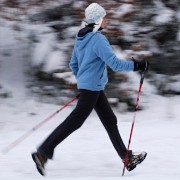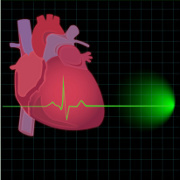 Photo: Getty Images
Photo: Getty Images
I’m a couch potato in a family of sports fanatics. Given the choice, I’d much rather watch my favorite sport on television from the comfort of my favorite armchair, with the air conditioner going full blast and a glass of cold iced tea nearby to fend off sympathy sweat! I never could quite figure out why playing the piano didn’t qualify as exercise. Unfortunately for me, my love of a good book rather than a jog around the block is doing much more damage than just enabling me to wear a few more pounds than I’d like. My activity level, or lack thereof, has also put me at an increased risk of developing cardiovascular (heart) disease.
Exercise - or to be more precise, the lack of exercise - is one of the major risk factors associated with the development of heart disease. Those of us who are afflicted by a love affair with the couch are twice as likely to develop heart disease as our counterparts who are physically active. Not only does lack of exercise, or “physical activity” if you want to be politically correct, increase your risk of heart disease, it also increases your risk of stroke and can lead to obesity. When you stop to consider it, that makes perfect sense – if you don’t expend more calories than you take in, obesity is the natural result. Obesity creates a negative cascade effect on your health and leads you down the path to high blood pressure, diabetes, and high cholesterol--all of which in turn increases your risk of heart disease even more.
Eliminating this risk factor is simple – make a decision to increase your physical activity level and then do it. Get up off the couch, put one foot in front of the other and move! Actually, it’s not quite as simple as it sounds. The American Heart Association (AHA) recommends getting 30 minutes of exercise every day. When it comes to getting the recommended amount, women fare much worse than men. Estimates are that 60 percent of all women fall short of this target. We’re also much more likely (41 percent) to not exercise or engage in any physical activity at all. Those numbers really come as no surprise considering the stresses and roles that women play today both at work and home. When it comes to the delicate act of balancing the needs of family against work, the loser is often the woman who plays superwoman to meet the needs of her boss and family while sacrificing her own health. Unfortunately, with heart disease being the number one killer of women in the United States, it’s time to remember that “self” matters and incorporate healthy activity levels into your lifestyle.
If you’re just starting out, one of the first things you’ll want to do is talk to your doctor. Make certain that you don’t have any physical limitations that prevent you from exercise. After all, the goal is to get healthier, not to cause an injury. Once you have the green light from your doctor, choose an activity. To gain the most benefit, look for aerobic exercise that requires constant or continuous motion such as walking, jogging, dancing, skiing, or cycling. Rowing, swimming, and stair-climbing are also excellent physical activities as are some team sports such as basket ball and soccer.
If you’re not quite ready to jump into more vigorous activities, then start with a more moderate-activity focused exercise. Moderate-activities include such things and housework, gardening, yard work, and some home exercise. Tennis, touch football, racquetball and other recreational activities which are not constant motion are also a good way to start engaging in physical activity if you’re just getting started.
In starting an exercise program, it’s important to pick something that you like or will enjoy. If you enjoy the activity, you’re much for likely to stick with it. For example, I love NIA (non-impact aerobics) because it’s based on dance forms and I make a real effort to attend. If my only option were soccer, I’d probably pass. When starting any exercise program, make certain you have the right equipment. If you’re jogging, do you have the right shoes? Right clothes? If you’re not comfortable, you won’t be successful. Make an exercise “date” with yourself each day at the same time. Remember, this is your personal time to invest in your future, your longevity, and your health so don’t let others rob you of that time. Having a set time for your date sends the message to others that this time is off limits and they are less likely to interfere. Also, meet yourself where you are and don’t compare to others. My sister wanted me to run a 5K with her. She’s 12 years younger than I am. We are not going to start (or end) at the same place. Start slow and build an exercise program that works for you. If possible, get a girlfriend to join you. Not only are you more likely to commit and stick with it if someone is depending on you, but you just may save your friend’s life as well.
No matter where you are now, physical activity benefits your heart health. You’ll enjoy lower blood pressure and regular exercise helps control cholesterol levels. Regular activity will also help you control your weight and diabetes. Even those who have already had a first heart attack were found to benefit from regular exercise and enjoyed not only an improved quality of life but a greater overall survivability. While exercise may not be your thing, it just may be the thing that saves you from heart disease.
Sources:
Heart Disease, The Mayo Clinic, 12 Jan 2011, http://www.mayoclinic.com/health/heart-disease/DS01120
Women, Heart Disease, and Stroke, The American Heart Association, 19 Jan 2011, http://www.americanheart.org/presenter.jhtml?identifier=4786
Subtle and Dangerous: Symptoms of Heart Disease in Women (Results from Studies Supported by the National Institute of Nursing Research), National Institute of Health Publication No. 06-6079
Physical Activity, American Heart Association, (AHA Scientific Position), http://www.americanheart.org/presenter.jhtml?identifier=4563
How Can Physical Activity Become a Way of Life, American Heart Association, http://www.americanheart.org/downloadable/heart/1196270360905Activity_wayoflife.pdf





Add a Comment2 Comments
Hi Danny,
February 24, 2011 - 9:56amThanks for weighing in (no pun intended!) on the issue. You bring up a great point about making exercise fun. I'm really "in" to music and exercise that involves music makes (like NIA or Zumba) is more motivational to me and I'm more likely to keep coming back if music is involved. I also have a granddaughter who's 10 and really loves to ride bikes. We do about a 6 mile circuit 3-4 times a week. That's fun because I don't view it as "exercise" but as time to spend with her. Thanks again for writing!
This Comment
The lack of exercise is one of the primary risks to obesity and obesity related health conditions. If exercise is something your struggle with, try to make it fun. You will be more likely to get active if you enjoy doing it, whether you work out at home, or walk around the park. The most important thing is to get moving and stay focused on your goals!
Danny Lupiani
February 10, 2011 - 7:55amwww.athleticfx.net
This Comment